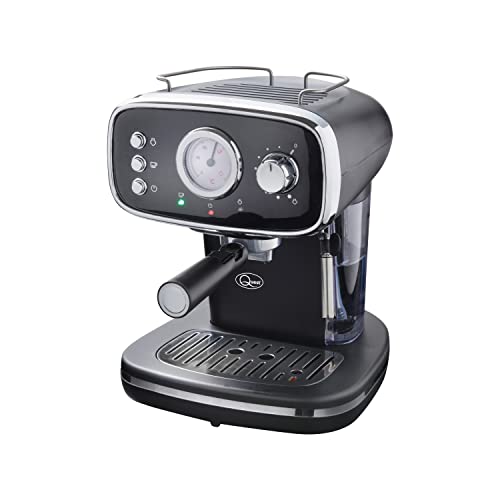How to Build a Professional Espresso Machine
This is a fantastic option for cafes and coffee shops that wish to attract customers who are passionate about barista and espresso skills. It's the official machine used for World Barista Championships and it truly shows.
The barista is able to refill the reservoir with water throughout their shift. The machine is equipped with an hot water tap for tea and steam wands that cool-touch.
Water
A commercial espresso machine is required to produce a large quantity of espresso-based drinks efficiently. That's why these machines are generally constructed from stainless steel which is more robust and resistant to scratches and breaks. Espresso machines made of stainless steel make it easier to maintain and clean.
Finally, a high-quality machine has a shut-off valve for the water line in order to prevent the buildup of limescale. espresso coffee machine uk will ensure that any repairs are isolated to the specific machine components and won't affect the rest of your operation.
When you select your water ensure that you test it thoroughly and treat it in a way to ensure the best results. For instance distillate water can be remineralized by adding a small amount of minerals back to it. It can enhance the taste and negate its erosive properties, but can also harm certain machines. The remineralized water will make the boiler sensor believe that the machine is full however it's not. This can lead to overheating and even damage to the machine.
Grinder
The grinder is a crucial component of a successful espresso maker. It is a process that takes a raw, unground bean and turns it into finely ground coffee that can then be tamped into the filter basket to create an excellent extraction.
Commercial-grade professional machines include grinders that are programmed to work with different sizes of drink. This ensures the same results every time. Super-automatic machines go one step further and automatize the entire process from brewing, to grinding and dispensing. These machines are often praised in Lab tests for being easy to use.

A manual or semi-automatic espresso machine requires more involvement from the barista, however the quality of the end result is often worth the effort. This model was awarded an award called the Good Housekeeping Coffee Award in 2022 for its clever dosing mechanism that measures and dispenses the right amount of coffee every time. It also comes with a low-pressure pre-infusion mechanism for balanced extraction and an ice cream wand that excelled in our test for producing rich, thick steaming milk.
Temperature
When it is time to make espresso temperature, it plays an important impact on the flavor and quality of your espresso. If the water isn't in its ideal temperature, it can hinder extraction and even lead to the coffee being bitter.
Fortunately, high-quality espresso machines come with tools that will allow you to ensure that your water is at the right temperature. A PID monitors and regulates temperature of the water. Double boiler systems are another way to accomplish this. One boiler can be used to heat water and steam for tea, while using another to heat the water to brewing temperature.
Carles explains how these systems can make a difference for both large-scale businesses as well as baristas at home. They can make it easier for newbies to make the perfect espresso because they can maintain an exact temperature and eliminate many of the variables that can throw off the flavor profile. It is also much easier for baristas with more experience to dial in their shots just the way they want.
Pressure
The pressure an espresso maker uses is another aspect that affects the quality of the coffee it makes. Many espresso drinkers have noticed that their coffee tastes differently based on the pressure used, even if other factors remain constant.
The majority of commercial machines utilize 9 bars of pressure in order to make espresso. These machines are also likely to be driven by pumps rather than steam-driven. Although high-pressure machines are offered, they require a group head that is more sophisticated to handle the increased levels of pressure.
While some espresso machines advertise 15 or 18 bars of pressure on their machines Nine bars are generally considered to be the gold standard for making consistently excellent espressos. These machines that are higher pressure are generally less expensive and are intended for use at home.
In comparison, 9 bars of pressure is four times greater than the pressure applied by your car tire. The greater the pressure that a professional espresso machine is able to apply and the more effective it will be at removing the flavor from your favorite coffee beans. It's worthwhile to invest in high-end machines that can produce the most effective results.
Barista Skills
Baristas must be able to accept and process orders of customers quickly and efficiently. This is especially important during busy times in the coffee shop. Good customer service skills is also crucial for establishing customer relationships and increasing business for the shop. This can include acknowledging regular customers, working to resolve problems efficiently, and remaining positive and helpful in difficult situations.
Baristas typically need to be skilled at multitasking, since they are expected to take orders and operate a cash counter, communicate orders with coworkers and handle phone calls at the same time. This skill allows the customer to enjoy a pleasant coffee shop experience by ensuring that orders get delivered quickly.
It is important for baristas to be able to make various drinks using an espresso machine. You can get acquainted with the various types of espresso by reading about their characteristics, tasting them in person, or watching online videos. Many baristas find it helpful to attend classes provided by various organizations.
